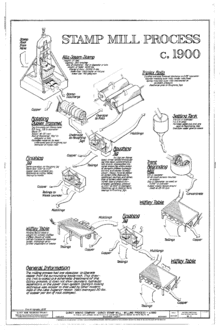
Keweenaw County is a county in the western Upper Peninsula of the U.S. state of Michigan. As of the 2020 census, the county's population was 2,046, making it Michigan's least populous county. It is also the state's largest county by total area, including the waters of Lake Superior, as well as the state's northernmost county. The county seat is Eagle River.

Houghton County is a county in the Upper Peninsula in the U.S. state of Michigan. As of the 2020 census, the population was 37,361. The county seat and largest city is Houghton. Both the county and the city were named for Michigan State geologist and Detroit Mayor Douglass Houghton.
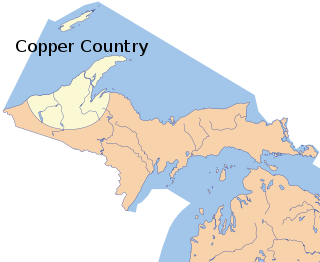
The Copper Country is an area in the Upper Peninsula of Michigan in the United States, including Keweenaw County, Michigan, Houghton, Baraga and Ontonagon counties as well as part of Marquette County. The area is so named as copper mining was prevalent there from 1845 until the late 1960s, with one mine continuing through 1995. The region includes Copper Island, Copper Harbor and Isle Royale. In its heyday in the latter half of the 19th century and the early 20th century, the area was the world's greatest producer of copper.

M-26 is a 96.355-mile-long (155.068 km) state trunkline highway in the U.S. state of Michigan, running from two miles (3.2 km) east of Rockland to its junction with US Highway 41 (US 41) in Copper Harbor. It generally runs southwest-to-northeast in the western half or Michigan's Upper Peninsula. The northernmost segment, which closely parallels the shore of Lake Superior on the west side of the Keweenaw Peninsula, is highly scenic.

The Quincy Mine is an extensive set of copper mines located near Hancock, Michigan. The mine was owned by the Quincy Mining Company and operated between 1846 and 1945, although some activities continued through the 1970s. The Quincy Mine was known as "Old Reliable," as the Quincy Mine Company paid a dividend to investors every year from 1868 through 1920. The Quincy Mining Company Historic District is a United States National Historic Landmark District; other Quincy Mine properties nearby, including the Quincy Mining Company Stamp Mills, the Quincy Dredge Number Two, and the Quincy Smelter are also historically significant.
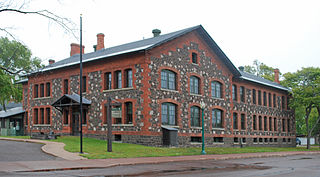
Keweenaw National Historical Park is a unit of the U.S. National Park Service. Established in 1992, the park celebrates the life and history of the Keweenaw Peninsula in the Upper Peninsula of the U.S. state of Michigan. It is a federal-local cooperative park made up of two primary units, the Calumet Unit and the Quincy Unit, and almost two dozen cooperating "Heritage Sites" located on federal, state, and privately owned land in and around the Keweenaw Peninsula. The National Park Service owns approximately 1,700 acres (690 ha) in the Calumet and Quincy Units. Units are located in Baraga, Houghton, Keweenaw, and Ontonagon counties.

The Redridge Steel Dam is a steel dam across the Salmon Trout River in Redridge, Houghton County, Michigan. Completed in 1901, it is a flat slab buttress dam constructed of steel, a relatively rare material for construction of dams, which are typically made of earthenworks, concrete, or masonry. Most sources indicate that it was one of only three such dams constructed in the United States, the other two being the Ashfork-Bainbridge Steel Dam and the Hauser Lake Dam, the last of which failed within a year of construction.
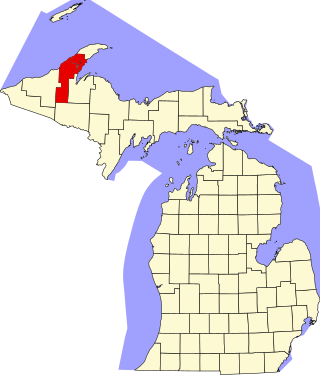
This is a list of the National Register of Historic Places listings in Houghton County, Michigan.

Freda is an unincorporated community fifteen miles west of Houghton, United States in Stanton Township.

In Michigan, copper mining became an important industry in the 19th and early 20th centuries. Its rise marked the start of copper mining as a major industry in the United States.
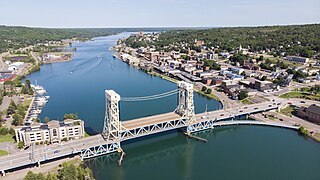
The Houghton Micropolitan Statistical Area, as defined by the United States Census Bureau, is an area consisting of two counties in the Upper Peninsula of Michigan, specifically the Keweenaw Peninsula, anchored by the city of Houghton.
The Michigan Smelter was a copper smelter located at Cole's Creek on the Keweenaw Waterway north-west of Houghton, Michigan near the old Atlantic mill. The smelter was created in 1903-4 as a joint effort between the Copper Range Company and Stanton group of mines. An Atlantic dam on the site was reused by the smelter as a water source. In 1905, the smelter broke a world record by casting 292,000 pounds of fine copper in seven hours with a single furnace and only ten men. The smelter operated through World War II and stopped all operations in 1948.
The Atlantic Mill was located on the east side of Redridge, Michigan near the Redridge Steel Dam. It was constructed in 1892 and closed in 1912. It was connected to the Atlantic mine via a 9 mile long Atlantic and Lake Superior Railroard. The previous path of the railroad is now a scenic tree-covered road. It is thought that currents have moved the stamp sand produced by this mill to the current site of the North Canal Township Park.
The Victoria Mine is the name given to a series of copper mines located in Rockland Township, Ontonagon County, in Michigan's Copper Country. It was near this location that a large piece of float copper, known as the Ontonagon Boulder, was found. The mine operated off and on from 1849 until its final closure in 1921. Most of the metal found there was low grade native copper from the Forest Lode. Quartz, epidote, calcite, prehnite, and pumpellyite are also found in the rock.
The Lac La Belle and Calumet Railroad was an American, 3 ft narrow gauge railroad that operated in the Keweenaw Peninsula, or the extreme northern Upper Peninsula of Michigan. The line was owned by the Conglomerate Mining Company and ran between a stamp mill at Lac La Belle and the Delaware copper mine from 1883 to 1888, when poor economic conditions forced the line's closure.
The Mohawk Mining Company was a major copper mining company, based in the Keweenaw Peninsula of Michigan, that was established in November 1898 and lasted until 1932. The company, between 1906 and 1932, paid out more than $15 million in shareholder dividends. The Mine is best known for the large amounts of mohawkite that were found on the property. The Mohawk mine operated until 1932; in 1934 it was purchased by the Copper Range Company.
The Wolverine Mine was a small copper mining operation in the Keweenaw Peninsula of Michigan, that was in operation from January 1882 until November 1884. In August 1890, possession of the company was obtained and reorganized as the Wolverine Copper Mining Company. It mined the Kearsarge lode until 1922 when it closed.
Clarence J. Monette was a prolific author and historian from Michigan's Copper Country, writing extensively on Copper Country history. He has published more than sixty books and has written numerous outdoor survival guides.

